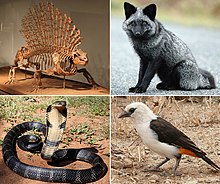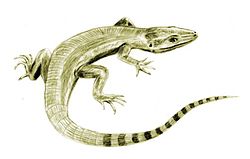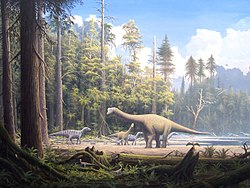Amniote
This article needs additional citations for verification. (August 2022) |
| Amniotes | |
|---|---|

| |
| From top to bottom and left to right, examples of amniotes: ). | |
| Scientific classification | |
| Domain: | Eukaryota |
| Kingdom: | Animalia |
| Phylum: | Chordata |
| Superclass: | Tetrapoda |
| Clade: | Reptiliomorpha |
| Clade: | Amniota Haeckel, 1866 |
| Clades | |
Amniotes are
All three main amniote features listed above, namely the presence of an amniotic buffer, water-impermeable
The first amniotes, referred to as "basal amniotes", resembled small lizards and evolved from semiaquatic
Etymology
The term amniote comes from the amnion, which derives from Greek ἀμνίον (amnion), which denoted the membrane that surrounds a fetus. The term originally described a bowl in which the blood of sacrificed animals was caught, and derived from ἀμνός (amnos), meaning "lamb".[10]
Description
Zoologists characterize amniotes in part by
Adaptation for terrestrial living
Features of amniotes evolved for survival on land include a sturdy but porous leathery or hard eggshell and an allantois that facilitates respiration while providing a reservoir for disposal of wastes. Their kidneys (metanephros) and large intestines are also well-suited to water retention. Most mammals do not lay eggs, but corresponding structures develop inside the placenta.
The ancestors of true amniotes, such as Casineria kiddi, which lived about 340 million years ago, evolved from amphibian reptiliomorphs and resembled small lizards. At the late Devonian mass extinction (360 million years ago), all known tetrapods were essentially aquatic and fish-like. Because the reptiliomorphs were already established 20 million years later when all their fishlike relatives were extinct, it appears they separated from the other tetrapods somewhere during Romer's gap, when the adult tetrapods became fully terrestrial (some forms would later become secondarily aquatic).[12] The modest-sized ancestors of the amniotes laid their eggs in moist places, such as depressions under fallen logs or other suitable places in the Carboniferous swamps and forests; and dry conditions probably do not account for the emergence of the soft shell.[13] Indeed, many modern-day amniotes require moisture to keep their eggs from desiccating.[14] Although some modern amphibians lay eggs on land, all amphibians lack advanced traits like an amnion.
The amniotic egg formed through a series of evolutionary steps. After internal fertilization and the habit of laying eggs in terrestrial environments became a reproduction strategy amongst the amniote ancestors, the next major breakthrough appears to have involved a gradual replacement of the gelatinous coating covering the amphibian egg with a fibrous shell membrane. This allowed the egg to increase both its size and in the rate of gas exchange, permitting a larger, metabolically more active embryo to reach full development before hatching. Further developments, like extraembryonic membranes (amnion, chorion, and allantois) and a calcified shell, were not essential and probably evolved later.[15] It has been suggested that shelled terrestrial eggs without extraembryonic membranes could still not have been more than about 1 cm (0.4-inch) in diameter because of diffusion problems, like the inability to get rid of carbon dioxide if the egg was larger. The combination of small eggs and the absence of a larval stage, where posthatching growth occurs in anamniotic tetrapods before turning into juveniles, would limit the size of the adults. This is supported by the fact that extant squamate species that lay eggs less than 1 cm in diameter have adults whose snout-vent length is less than 10 cm. The only way for the eggs to increase in size would be to develop new internal structures specialized for respiration and for waste products. As this happened, it would also affect how much the juveniles could grow before they reached adulthood.[16]
A similar pattern can be seen in modern amphibians. Frogs that have evolved terrestrial reproduction and direct development have both smaller adults and fewer and larger eggs compared to their relatives that still reproduce in water.[17]
The egg membranes
Fish and amphibian eggs have only one inner membrane, the embryonic membrane. Evolution of the amniote egg required increased exchange of gases and wastes between the embryo and the atmosphere. Structures to permit these traits allowed further adaption that increased the feasible size of amniote eggs and enabled breeding in progressively drier habitats. The increased size of eggs permitted increase in size of offspring and consequently of adults. Further growth for the latter, however, was limited by their position in the terrestrial
Amniote traits
While the early amniotes resembled their amphibian ancestors in many respects, a key difference was the lack of an
Post-cranial remains of amniotes can be identified from their
Definition and classification
Amniota was first formally described by the embryologist
Traditional classification
Older classifications of the amniotes traditionally recognised three classes based on major traits and physiology:[21][22][23][24]
- Class Reptilia (reptiles)
- Class Aves (birds)
- Subclass Archaeornithes (reptile-like birds, progenitors of all other birds)
- Subclass Enantiornithes (early birds with an alternative shoulder joint)[26]
- Subclass Hesperornithes (toothed aquatic flightless birds)
- Subclass Ichthyornithes (toothed, but otherwise modern birds)
- Subclass Neornithes(all living birds)
- Class Mammalia (mammals)
- Subclass Prototheria (Monotremata, egg-laying mammals)
- Subclass placental mammals))
This rather orderly scheme is the one most commonly found in popular and basic scientific works. It has come under critique from cladistics, as the class Reptilia is paraphyletic—it has given rise to two other classes not included in Reptilia.
Most species described as microsaurs, formerly grouped in the extinct and prehistoric amphibian group lepospondyls, has been placed in the newer clade Recumbirostra, and shares many anatomical features with amniotes which indicates they were amniotes themselves.[27]
Classification into monophyletic taxa
A different approach is adopted by writers who reject paraphyletic groupings. One such classification, by Michael Benton, is presented in simplified form below.[28]
- Series Amniota
- (Class) Clade Synapsida
- A series of unassigned families, corresponding to †
- (Order) Clade Therapsida
- Class Mammalia – mammals
- A series of unassigned families, corresponding to
- (Class) Clade Sauropsida
- Subclass †
- Family †
- Family †
- Family †
- Family †
- Order Pareiasauromorpha
- Family †
- Family †
- Family
- Family
- (Subclass) Clade Eureptilia
- Family †
- (Infraclass) Clade Diapsida
- Family †
- Family †
- Order †
- (Infraclass) Clade Neodiapsida
- Order Testudinata
- Suborder Testudines– turtles
- Suborder
- Infraclass Lepidosauromorpha
- Unnamed infrasubclass
- Infraclass †
- Order †
- Superorder Lepidosauriformes
- Order Sphenodontida– tuatara
- Order Squamata – lizards and snakes
- Order
- Infraclass
- Infrasubclass †
- Order †
- Order †
- Suborder †
- Suborder †
- Suborder
- Order †
- Order
- Unnamed infrasubclass
- (Infraclass) Clade Archosauromorpha
- Family †
- Order †
- Order †
- Division Archosauriformes
- Subdivision Archosauria
- Infradivision Crurotarsi
- Order Phytosauria†
- Family †
- Family †
- Family †
- Superfamily †
- Superorder Crocodylomorpha
- Order Crocodylia – crocodilians
- Order
- Infradivision Avemetatarsalia
- Infrasubdivision Ornithodira
- Order †
- Family †
- Family †
- (Superorder) Clade Dinosauria– dinosaurs
- Order †
- (Order) Clade Saurischia
- (Suborder) Clade Theropoda – theropods
- Class Aves– birds
- Class
- (Suborder) Clade Theropoda – theropods
- Order
- Order
- Infrasubdivision
- Infradivision Crurotarsi
- Subdivision
- Family
- Order Testudinata
- Family
- Family
- Subclass
- (Class) Clade Synapsida
Phylogenetic classification
With the advent of cladistics, other researchers have attempted to establish new classes, based on
Cladogram
The
| Reptiliomorpha |
| ||||||||||||||||||||||||||||||||||||||||||||||||
Following studies in 2022 and 2023,
| |||||||||||||||||||||||||||||||||||||||||||||||||||||||
References
- S2CID 204992355.
- S2CID 46418796.
- ISBN 978-0-412-73810-4.
- ^ Cieri, R.L., Hatch, S.T., Capano, J.G. et al. (2020). Locomotor rib kinematics in two species of lizards and a new hypothesis for the evolution of aspiration breathing in amniotes. Sci Rep 10. 7739. https://doi.org/10.1038/s41598-020-64140-y
- ^ Janis, C. M., Napoli, J. G., & Warren, D. E. (2020). Palaeophysiology of pH regulation in tetrapods. Philosophical Transactions of the Royal Society B: Biological Sciences, 375 (1793), 20190131. https://doi.org/10.1098/rstb.2019.0131
- ISBN 978-1-259-56231-0.
- ^ ISBN 978-0-07-352423-8.
- ISBN 978-0-253-35675-8.
- ^ PMID 17047029.
- ^ Oxford English Dictionary
- PMID 12560472.
- ^ "the_mid_palaeozoic_biotic_crisis – Ocean and Earth Science, National Oceanography Centre Southampton – University of Southampton".
- ^ Stewart J. R. (1997): Morphology and evolution of the egg of oviparous amniotes. In: S. Sumida and K. Martin (ed.) Amniote Origins-Completing the Transition to Land (1): 291–326. London: Academic Press.
- S2CID 84258651.
- ^ Shell Game » American Scientist
- PMID 15371249.
- ^ Gomez‐Mestre – 2012 – Evolution – Wiley Online Library
- ^ Lombard, R. E. & Bolt, J. R. (1979): Evolution of the tetrapod ear: an analysis and reinterpretation. Biological Journal of the Linnean Society No 11: pp 19–76 Abstract
- ^ a b Gauthier, J., Kluge, A.G. and Rowe, T. (1988). "The early evolution of the Amniota." Pp. 103–155 in Benton, M.J. (ed.), The phylogeny and classification of the tetrapods, Volume 1: amphibians, reptiles, birds. Oxford: Clarendon Press.
- .
- ^ Romer A S and Parsons T S (1985) The Vertebrate Body. (6th ed.) Saunders, Philadelphia.
- ^ Carroll, R. L. (1988), Vertebrate Paleontology and Evolution, WH Freeman & Co.
- ISBN 978-0-471-29505-1.
- ISBN 978-0-471-38461-8.
- PMID 25803280.
- ISBN 0-520-20094-2
- ^ Tiny ancient reptile named after Thor's world-ending nemesis
- ISBN 978-1-118-40684-7.
- ^ Lee, M.S.Y. & Spencer, P.S. (1997): Crown clades, key characters and taxonomic stability: when is an amniote not an amniote? In: Sumida S.S. & Martin K.L.M. (eds.) Amniote Origins: completing the transition to land. Academic Press, pp 61–84. Google books
- ^ David S. Berman (2013). "Diadectomorphs, amniotes or not?". New Mexico Museum of Natural History and Science Bulletin. 60: 22–35.
- .
- ISSN 2296-701X.
- doi:10.1111/j.1096-3642.1995.tb00932.x. Archived from the original(PDF) on 8 June 2019. Retrieved 2 November 2017.
- S2CID 4264378.
- ISBN 978-3-89937-052-2.
- PMID 21775315.
- PMID 15625185.
- PMID 17719245.
- S2CID 12116018.
- PMID 35984885.
- PMC 10499374.
- S2CID 83840423.













